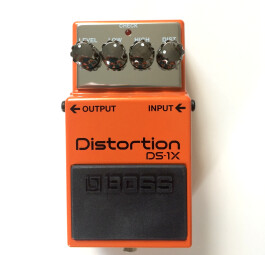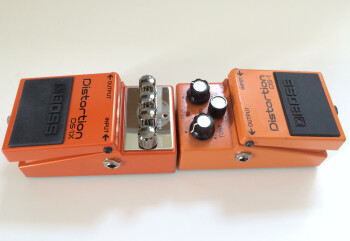This year, Boss has been releasing new stompboxes at a prodigious pace: two at Winter NAMM and three at Summer NAMM. All are reinventions of older Boss pedals. The DS-1X, released along with the OD-1X in January, is a revamped digital version of the DS-1. How does it compare to its predecessor? We tested them head to head as part of this review.
A classic pedal reborn
The DS-1X is a completely revamped pedal from its predecessor, the venerable DS-1, which has been part of the Boss pedal lineup since 1978. Although it maintains the classic Boss body shape, battery compartment and power-adapter input, the DS-1X has a slightly different control set. Both pedals have a Level and a Distortion control, but while the DS-1 has a single tone control, the DS-1X features Low and High controls, giving it more sonic flexibility.
From a looks standpoint, the DS-1X, like the OD-1X, sports a mirrored top, which gives it a spiffier look than the DS-1. The DS-1X can be powered either by a 9V battery (included) or an optional Boss PSA adapter or equivalent 9V power supply. The DS-1X is just about three times as expensive as the DS-1.
Besides the price, the biggest difference between the pedals is on the inside. The DS-1X uses the company’s “Multidimensional Processing, ” which is digital (same technology used on the OD-1X), whereas the DS-1 is analog. Although in most cases I’d choose an analog pedal over a digital one, that’s not the case here.
The DS-1X has a more complex sound. It’s smoother, has more sustain, more overtones and harmonics. By comparison, the DS-1 sounds like the $49 pedal that it is. The only area where the DS-1 is superior is presence — it’s much more "in your face” that the DS-1X, which is a bit compressed sounding.
Boss says the new pedal is “ultra responsive to volume changes and picking dynamics, ” and I would agree that it’s definitely improved in that area.
DS pedals go head to head
To give you an idea of the sonic differences between the pedals, here is a series of comparisons, where I’m playing similar parts through both pedals, using the same amp, a Fender Blackface Twin Reverb reissue, miked by a Shure SM57. The guitar used was an ESP 400 series Strat with Fender Lace Sensor pickups.
Here’s a high-gain rhythm part.
First, the DS-1:


Here’s the DS-1:


Now a comparison with lower gain settings on a rhythm guitar part.
The DS-1:


This time we’ve dialed up an even lower gain setting, for a blues-rock rhythm guitar part.
First the DS-1:


And lastly some lead playing at the same settings as the previous example.
The DS-1:


X marks the spot
The DS-1X ($149) offers a lot more sonic flexibility than its predecessor. It definitely provides a rich distortion with lots of sustain. I wish it was a tad less compressed sounding, with a bit more bite, but overall it’s a good sounding pedal that offers warm and modern-sounding distortion. While it beat the DS-1 rather handily in our comparisons, how it fares on the market, with a lot of other distortion pedals to choose from, remains to be seen.


